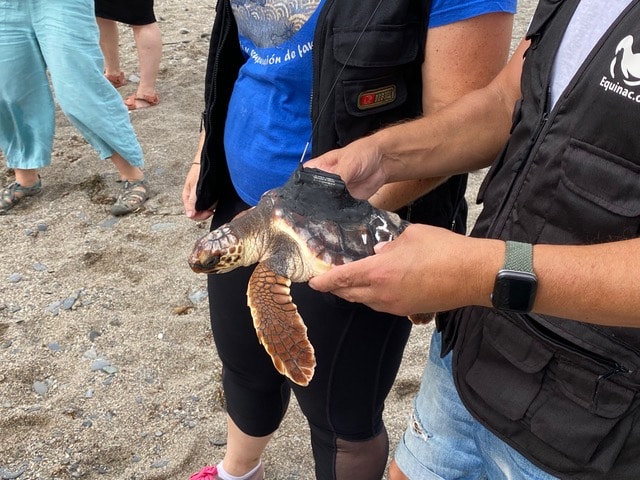Now swimming free on the Mojácar coast the 20 small turtles which just a year ago saw the light for the first time in this locality.
They were returned to the sea by the people who had been looking after them during this time, by students from the Mojácar Rey Alabez Institute who took part in the beach waste collection programme; the Red Cross, which, along with volunteers, also held a day of cleaning up and raising awareness about the conservation of our coasts; the security forces that guarded the nest to protect it, night and day; Environment and Mayor of Mojácar, Rosa María Cano, as well as the Andalucía Regional Minister for Agriculture, Fishing and Rural Development, Carmen Crespo, and many onlookers who didn’t want to miss the moment.
Before starting on this adventure which has led to their freedom, the 20 small loggerhead turtles spent the first days of their lives in the Junta de Andalucía CEGMA marine environment recovery centre in Algeciras.
Four very delicate months in the survival of this species, but at this centre they now have experience in the care of new-born turtles.
Care means 24 hours of continuous surveillance: stable temperature, balanced diet, the initial days with purees so that they don’t struggle with chewing a lot, and identification and personalised health monitoring.
They have to go from the 15-20 grammes they weigh at birth to the kilo they weigh when set free.
After the initial months, 10 of them remained at the CEGMA centre, five were transferred to the Seville aquarium and the other five to the Equinac NGO facilities in Almerimar.
With this distribution the experts tried to minimise risks, in the event they could arise, as well as set up teams and experts who can collaborate and take responsibility for new animals in the event of needing support in this kind of care.
There is an attitude of learning and collaboration between all the centres. The fact that the turtles nest here is a phenomenon which is occurring at many points on the Spanish coast, and which requires being prepared. It is important to have a good network of coordination and work at the technical level.
The Mojácar turtles have started their new lives with a number on their shells which will identify them in the initial days of their lives. Number 18 has a built-in GPS which traces its movements via satellite and will allow the Equinac experts to follow it and learn more about its life and behaviour.
The loggerhead turtle inhabits the Pacific and Indian Ocean, as well as the Mediterranean. In the eastern Mediterranean there is a colony of turtles, but usually they do not go beyond Corsica or the Balearic Islands.
In the western Mediterranean there are young animals which come from Florida and Cape Verde, spending the first years of their lives in the area as they cannot leave because the currents of the straits prevent them from doing so until they are of sufficient size and strength.
These nestings on the Spanish coast are a historical fact. An incredible fact which has the scientists looking for answers, beginning with the hypothesis that the turtles, due to living in tropical zones and to global warming, look for lower temperatures, like those on our coasts.
You have to keep in mind that the sex of the turtles is defined during incubation and as a consequence of the air temperature and that of the sand. With high temperatures females are born, and in the event of continuing to nest in tropical zones and without the guarantee of sex diversity, they could become extinct.
The nesting season starts now. It’s impossible to know if they will return to the beaches of Mojácar or not, but in any case, if you spot the trace of a turtle on the beach or even the female herself, it is very important not to touch her, not to touch anything, not to bother them with photos and a flash, and to immediately call 112.





